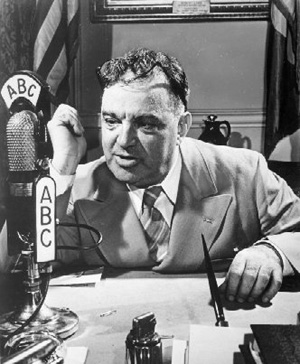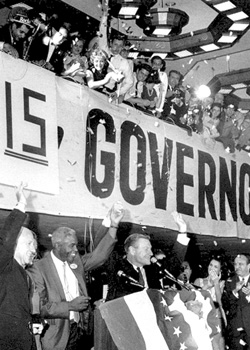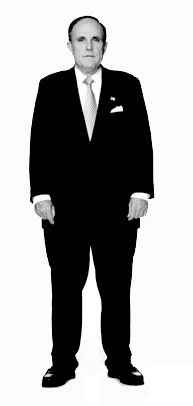|
|
1854 - Birth of the Party
Anti-slavery advocates, including Abraham Lincoln, spearhead the creation of the national Republican Party. The New York City Chapter is also established, with Horace Greeley, publisher of the New York Tribune.
1854 - Early Victory
Myron Holley Clark is elected the first Republican governor of New York.
1857 - Police Dispute
The Republican-controlled state legislature creates the Metropolitan Police, effectively abolishing New York City's Municipal Police. Although Democratic Mayor Fernando Wood resists, the state government prevails, and the Metropolitan Police patrol New York until 1870, when police power is restored to the local level.
1858 - Republican Endorsement
After the state legislature strips Wood of his power, Daniel Tiemann, a Democrat and wealthy paint manufacturer, is elected mayor with Republican support. He will serve for only two years before Wood returns to power.
1860- Historic Oratory
Abraham Lincoln gives his famous Cooper Union Address, which paves his way to the Republican presidential nomination later in the year.
|
|
1862 - First Republican Mayor
George Opdyke, a clothing manufacturer, financier, and member of the state Assembly, become the first Republican to be elected mayor. His two years in office will be marked by the draft riots of 1863, during which he refuses to negotiate with the rioters. In the history if the city, seven Republicans have served as mayor.
1874 - Animal Imagery
New York cartoonist Thomas Nast gives the GOP its symbol when he depicts Republican voters as an elephant in a cartoon for Harper's Weekly. The inspiration came from a hoax perpetrated by the New York Herald, which falsely reportedly that elephants from a menagerie had escaped into Central Park where they were foraging for food.
1886 - Losing Effort
Republican Theodore Roosevelt, a member of one of the city's most prominent families and a former state assembly member, comes in third in a bid for mayor.
1895 - A Strong Mayor
After a long drought, another Republican, reformer Republican William L. Strong, is elected mayor. He will go on to reorganize the city's street cleaning department, establish the Board of Education and create small parks in the city, but will lose the 1897 election partly because of his enforcement of blue laws and anti-Catholic school measures.
|
|
1895 - Police Commissioner
Strong appoints Theodore Roosevelt president of the city's Board of Police Commissioners. Roosevelt then establishes the foundation of the Police Academy and imposes stricter discipline on police officers. He will leave the post in 1897 to become secretary of the Navy and will later serve as governor of New York, vice president and, after the assassination of William McKinley in 1901, as president of the United States.
1901 - Reform Alliance
Seth Low, a former mayor of Brooklyn and president of Columbia University, is elected on a fusion ticket backed by the Republican and Citizens Union parties. He is credited with introducing civil service and a merit system for hiring city employees, lowering taxes while streamlining government services, improving the school system, and reducing graft in the police department. In 1903, he will lose the mayoralty to Democrat George McClellan, Jr.
|
|
1909 - Legislative Branch
Allied with Fusion candidates, the Republicans gain a majority on the Board of Alderman, a precursor to the City Council.
1911 - Serving Both Parties
Republican President William Howard Taft names Henry Stimson, a New York lawyer and U.S. attorney for New York, secretary of war. He will later be secretary of state in the Hoover administration and secretary of war under Franklin Roosevelt, a Democrat.
1916 - La Guardia in the House
Future mayor Fiorello LaGuardia, a Republican, wins a congressional seat from heavily Democratic East Harlem. He will remain in Congress, with a couple of interruptions, until 1932.
|
|
1924 - Presidential Politics
Calvin Coolidge carries New York City in the presidential election, the last Republican ever to do so.
1934 - Fusion Mayor
With support from Republicans and reformers, Fiorello H. La Guardia is elected to the first of three terms as mayor. Although a Republican, he works closely with the President Franklin Roosevelt to secure funding for large public works projects. He achieves the unification of the city's rapid transit system, reforms surface transit, pushes for a new City Charter, and expands city parks and cultural programs.
1937- Never a President
After achieving fame for his prosecution of organized crime figures, Thomas Dewey is elected district attorney of Manhattan. Six years later, he will become governor of New York and then an unsuccessful presidential candidate, losing to Franklin Roosevelt in 1944 and Harry Truman in 1948.
1946- Two Houses
Jacob Javits of the Lower East Side is elected for the first of four terms in the Congress. He will serve in the House until 1954, and then go on to the Senate where he will stay until 1981. His achievements include playing a major role in the passage of the Civil Rights Act of 1964.
1958 - Four terms
Nelson Rockefeller, a scion of the wealthy family who grew up partly in New York City, is elected to his first term as governor. Despite three unsuccessful attempts at the presidency, he will be re-elected governor four times before resigning in 1973 and briefly serving as vice president. As governor, he created the Metropolitan Transportation Authority.
|
|
1965 - Liberal and Republican
Republican John V. Lindsay is elected mayor. Labor strife turns out to be the bane of Lindsay's administration. He also expands city services and seeks to give blacks and Hispanics a great voice in the city. In 1969, Lindsay will fail to receive the Republican nomination for mayor but will win re-election on the Liberal Party line.
1975 - Famous Front Page
With New York City slashing services to avoid defaulting on its bonds, Republican President Gerald Ford vows to defeat any federal bail-out of the city, prompting the Daily News to print the headline, "Ford to City: Drop Dead." After city unions release funds to provide some relief, Ford relents and approves a federal loan guarantee for the city.
1993 - From Prosecutor to Mayor
After losing the 1989 mayoral race, Republican Rudolph W. Giuliani is elected 107th mayor of New York City. His administration will be noted for a large reduction in crime in the city and revival of many neighborhoods. He receives national acclaim for his handling of the September 11, 2001 terrorist attacks on the city, but leaves office in 2002 because of term limits.
|
|
1993 - Two Terms and Out
Wealthy Republican Ronald Lauder successfully proposes and backs a referendum limiting New York City officials to two terms in office.
2001 - Billionaire Republican
A registered Democrat, millionaire businessman Michael Bloomberg changes his party affiliation and gets the Republican nomination for mayor. He wins the general election after a campaign in which he spends nearly $70 million of his personal fortune. This marks the first time a Republican has ever followed another Republican in the mayor's office.
|
|
2004 - Meeting in New York
For the first time in history, the Republican National Convention will take place at Madison Square Garden. It is expected to generate $150 million in economic activity and be attended by 50, 000 people.







